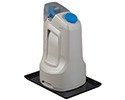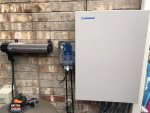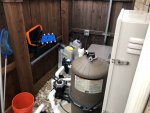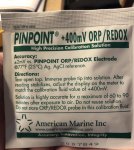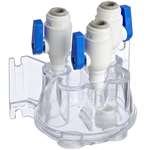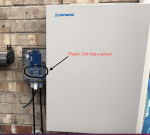Hello all,
Happy New Year!
I've learned a lot from this site over the past few months and felt it was time to contribute. I'm a big fan of automation and wanted to document my experience planning, installing, and maintaining Hayward's Sense & Dispense system. I've heard some mixed reviews related to this product mostly around the use of ORP to measure sanitization effectiveness. Yes I know the use of ORP is NOT recommended, but I think there is value in the measurement as long as you understand what it is and what it isn't. There is quite a bit of information online about ORP and the benefits attached to this unit of measurement. My goal is to leverage the system to its fullest capacity, integrate TFP methodology where possible, and minimize the day to day labor required to maintain my pool. Those interested in understanding my current setup my signature is up-to-date and my pool logs are available online.
Although I have the capability to install the system myself, I will be using my local Hayward Authorized Dealer. The main reason for this is to take advantage of the increased warranty length from 1 to 3 years when a Hayward Authorized dealer installs the system. In fact, to get the best price possible I was able to purchase the equipment from a different Hayward Authorized Online Reseller, then use my local Hayward dealer to do the install. By doing this I was able to save ~$1,300 in equipment cost and still get the 3 year warranty.
Below is a list of the major components included in the installation:
Technically I will need 2 Relays but since I already have an available relay in the system I only needed to order 1. The other misc hardware will be provided by my installer.
I expect the hardware to be shipped within the next few days and hope to have the install scheduled within the next week or so. In the meantime there is some prep work I need to complete to ensure a successful install.
Prep Work:
- Get my Water parameters in line. This is mostly to ensure proper ORP functionality and focused on CYA. Per the Sense & Dispense manual Hayward recommends CYA between 30-50ppm for an outdoor pool. I contacted Hayward specifically about the CYA issue and they specifically stated they were aware of issues with some ORP probes but that their probes were designed to be used under "normal" conditions? Of course I am NOT relying on this info, and after doing some research online I'm thinking CYA needs to be ~30ppm. And in some cases people have suggested ~25ppm. I think for now I'm going to target ~40ppm. I would prefer to utilize as much CYA as possible prevent having to continuously add liquid chlorine due to UV burn off.
- Make sure the area near my pool equipment can support 2 Containers, one for Muriatic Acid and one for Liquid Chlorine, each with a footprint of 16x16. See Pic Below. Although the area is somewhat flat, I think I'm going to put a piece of Slate/Stone in the area outlined in red. This should be large enough to fit 2 16x16 containers side by side facing the heater.
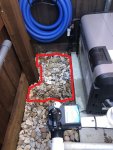
A picture of the Containers(includes Stenner Pump)
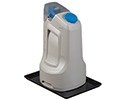
- Get some PH Calibration solution. Not sure the system will come with this so I searched up amazon and ordered this. Pinpoint is the manufacturer and know them well from my reef keeping days. The nice thing about this calibration solution is they are individual sealed packets. Tear the packet open, stick the probe in, then discard. Easy.
-Update my Omnilogic to latest firmware - DONE
Well thats it for now. Should be a pretty neat little project. Any feedback would be greatly appreciated. I will continue to post updates when available.
Happy New Year!
I've learned a lot from this site over the past few months and felt it was time to contribute. I'm a big fan of automation and wanted to document my experience planning, installing, and maintaining Hayward's Sense & Dispense system. I've heard some mixed reviews related to this product mostly around the use of ORP to measure sanitization effectiveness. Yes I know the use of ORP is NOT recommended, but I think there is value in the measurement as long as you understand what it is and what it isn't. There is quite a bit of information online about ORP and the benefits attached to this unit of measurement. My goal is to leverage the system to its fullest capacity, integrate TFP methodology where possible, and minimize the day to day labor required to maintain my pool. Those interested in understanding my current setup my signature is up-to-date and my pool logs are available online.
Although I have the capability to install the system myself, I will be using my local Hayward Authorized Dealer. The main reason for this is to take advantage of the increased warranty length from 1 to 3 years when a Hayward Authorized dealer installs the system. In fact, to get the best price possible I was able to purchase the equipment from a different Hayward Authorized Online Reseller, then use my local Hayward dealer to do the install. By doing this I was able to save ~$1,300 in equipment cost and still get the 3 year warranty.
Below is a list of the major components included in the installation:
| Code | Item | Qty |
| HL-CHEM | Hayward Omnilogic HL-CHEM Sense and Dispense | 1 |
| AQL-CHEM4-ACID | Hayward pH Acid Dispense Feed System AQL-CHEM4-ACID | 1 |
| AQL-CHEM4-CHLOR | Hayward Chlorine Dispense Feed System AQL-CHEM4-CHLOR | 1 |
| HLRELAY | Hayward OmniLogic 1 Relay Module HLRELAY | 1 |
Technically I will need 2 Relays but since I already have an available relay in the system I only needed to order 1. The other misc hardware will be provided by my installer.
I expect the hardware to be shipped within the next few days and hope to have the install scheduled within the next week or so. In the meantime there is some prep work I need to complete to ensure a successful install.
Prep Work:
- Get my Water parameters in line. This is mostly to ensure proper ORP functionality and focused on CYA. Per the Sense & Dispense manual Hayward recommends CYA between 30-50ppm for an outdoor pool. I contacted Hayward specifically about the CYA issue and they specifically stated they were aware of issues with some ORP probes but that their probes were designed to be used under "normal" conditions? Of course I am NOT relying on this info, and after doing some research online I'm thinking CYA needs to be ~30ppm. And in some cases people have suggested ~25ppm. I think for now I'm going to target ~40ppm. I would prefer to utilize as much CYA as possible prevent having to continuously add liquid chlorine due to UV burn off.
- Make sure the area near my pool equipment can support 2 Containers, one for Muriatic Acid and one for Liquid Chlorine, each with a footprint of 16x16. See Pic Below. Although the area is somewhat flat, I think I'm going to put a piece of Slate/Stone in the area outlined in red. This should be large enough to fit 2 16x16 containers side by side facing the heater.

A picture of the Containers(includes Stenner Pump)

- Get some PH Calibration solution. Not sure the system will come with this so I searched up amazon and ordered this. Pinpoint is the manufacturer and know them well from my reef keeping days. The nice thing about this calibration solution is they are individual sealed packets. Tear the packet open, stick the probe in, then discard. Easy.
-Update my Omnilogic to latest firmware - DONE
Well thats it for now. Should be a pretty neat little project. Any feedback would be greatly appreciated. I will continue to post updates when available.


